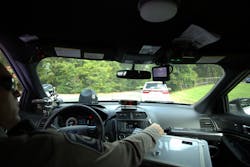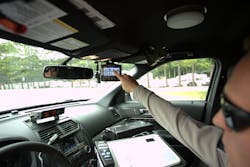BWCs Versus In-Car Video
Do you remember the first time you were video recorded by a civilian while you were trying to do your job on patrol? With roughly 77 percent of Americans now owning a smartphone, it’s no doubt that most in law enforcement have come across this at least once. Video technology is expanding in many industries—law enforcement included. In traffic enforcement stops in particular, body-worn cameras (BWCs) and in-car videos are two technologies that can strengthen officer accountability and credibility, increase transparency, improve evidence collection and help in the investigation of complaints. Despite the benefits, the integration of these two technologies in patrol vehicles is varied—while some agencies have one or both, other agencies have neither.
The value of BWCs in traffic stops
As the newer of both technologies, BWCs began gaining in law enforcement implementation within the last few years and have many benefits. According to Detective Chuck Love with the Louisa County Sheriff’s Office (Va.), body cameras have given credibility and integrity back to law enforcement. “It used to be that the police officer would report something and it was taken with more believability,” he says. “With the current way of thinking in reference to law enforcement, [body cameras] add back some of the credibility that we had in the past. When we can back up cases with actual audio or video from that stop, it adds credibility.”
Love notes that having body camera technology has completely changed the outlook of cases, too, once attorneys find out there is BWC footage. “We’ve had attorneys call us up and tell us ‘Our client said this and that’ and when we can prove with video that that’s not what happened, they say, ‘Oh you have BWC footage?’ Sometimes it’s enough to get a plea deal right away.”
BWCs can also protect officers on patrol, as shown earlier this year at the Brunswick County Sheriff’s Office (Va.). In April, Sgt. C.T. Sasser made a routine traffic stop for a speeding violation. Fifteen minutes later the driver recorded and posted a Facebook Live video depicting inaccuracies of what happened during the encounter, including her accusations of racial discrimination and threats. Sheriff Brian Roberts began receiving calls and messages from community members asking for answers. After viewing the officer’s BWC and in-car video footage, he found the sergeant acted “professionally and well within the realm of his duties.” He then published all unedited footage from the incident showing as much. “I can’t think of a situation where a body camera has in any way been negative,” he says. “My company and I love them because they protect us and they tell the truth. Even when it’s not pretty, when a deputy says a cuss word, for example. The point is it holds us accountable.”
Ever-changing technology
Though the Brunswick County Sheriff’s Office implemented body cameras in 2015, it had previously installed in-car video a decade earlier in 2005. Roberts says that while it might be redundant to have both technologies, everyone needs a backup plan to every scenario. The BWCs stay mounted on his deputies so when they are driving—whether they are civilian driving or Code 1 driving—nothing is being captured from their body. “It sits center on their chest so the issue is if I’m in a pursuit, if I just had the body camera, I wouldn’t have any footage in the pursuit, and if my officer does something right or wrong or whether the pursuit should have been terminated, the in-car camera is a necessity in those type of scenarios.”
Although body cameras are great for up close personal interactions with citizens, they lack two fundamental capabilities that an in-car camera system delivers during a roadside stop, says Brian Kirkham, vice president of marketing at WatchGuard Video. First, the in-car camera provides the critical, third-person point of view of the incident. Everything out in front of the car is captured, including how the officer approached the vehicle and interacted with the citizen, especially if he or she was asked to exit the vehicle. Secondly, the in-car system captures useful data leading up to and during the incident—metadata that’s not captured by the body camera, such as the patrol car’s speed, acceleration, braking, lightbar activation and GPS coordinates. Ideally, agencies should endeavor to use a single system that integrates an in-car camera and one or more body cameras, capturing synchronized video of an incident from multiple vantage points.
“I think it’s good to have both body camera and in-car video technology,” says Roberts. “If I had a system where the body camera was mounted in the windshield, acting as in-car video, when my officer gets in a foot pursuit, it’s another thing he has to remember to do. If I have both [technology] layers, that’s better. They serve two separate purposes and they can parallel each other and be a benefit. They can also stand alone and be a great benefit.”
The benefit of both
In a time when citizens constantly videotape law enforcement officers, it’s useful for LEOs to have their own video perspective. Video reveals information and can be used as a training tool—it can show where training fails and when officers are in the right. “Ten years ago maybe society trusted law enforcement more and didn’t challenge law enforcement enough, good or bad, but today with everyone recording what we do and we recording everything we do, I am not sure without BWCs how in the world we could ever defend ourselves,” says Roberts.
Certainly lack of money is a large detractor for agencies to get both technologies, but body cameras can pick up where in-car video lacks, and vice versa. Having both technologies is useful for information collection, improving accountability and giving credibility back to law enforcement in the field.




